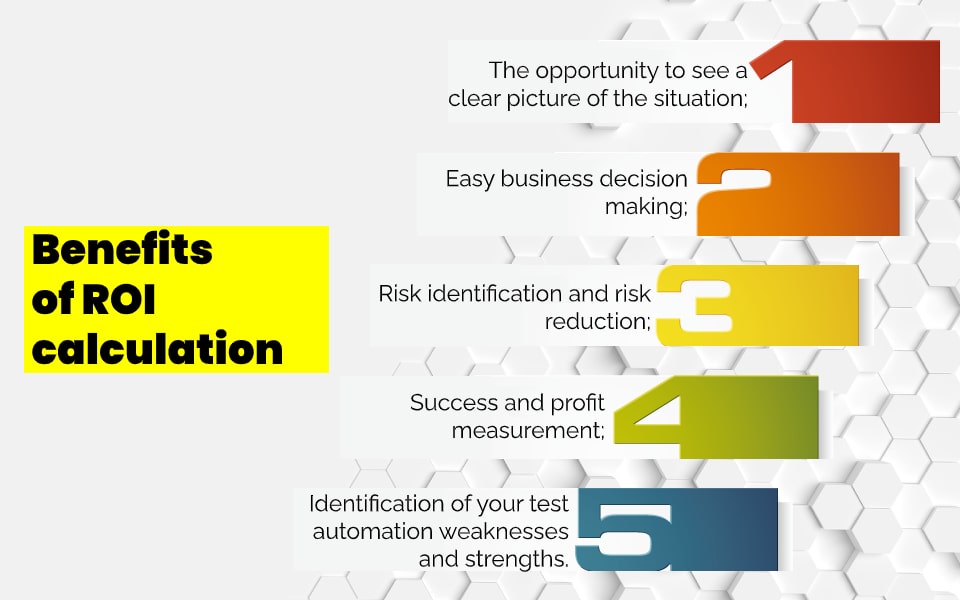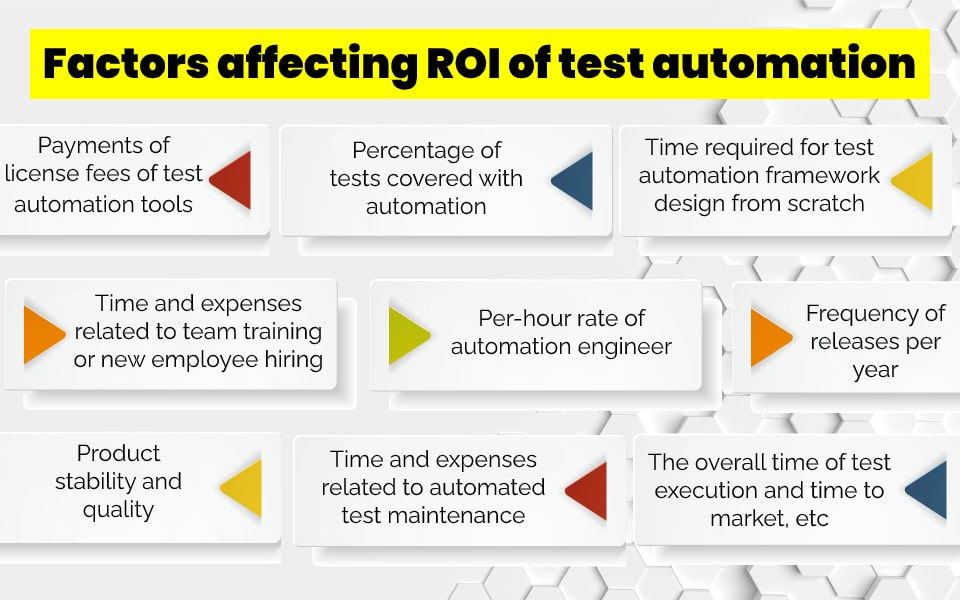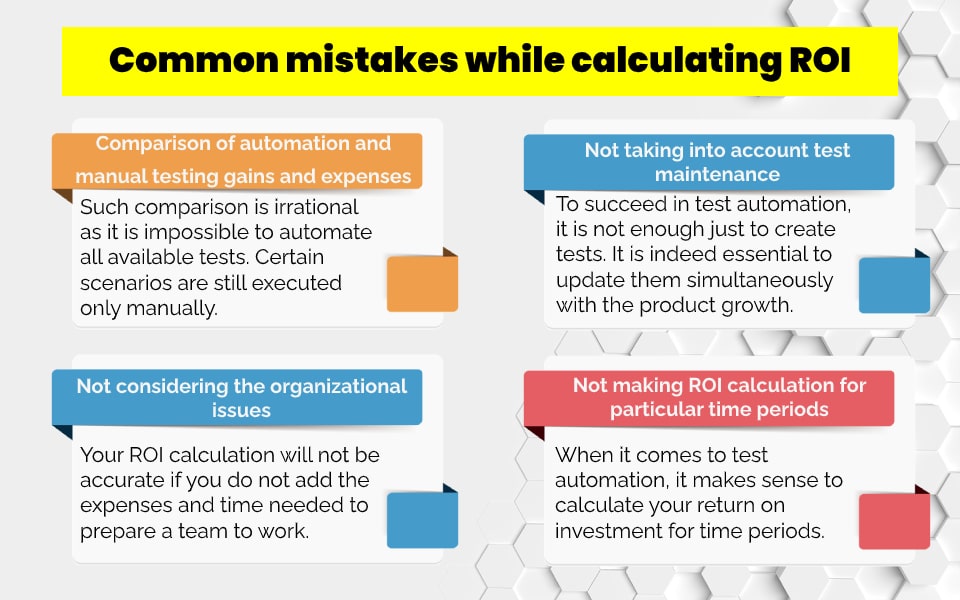The benefits of test automation are obvious and well-known. Taking into account the need for quick product delivery, more and more QA teams come to the conclusion that test automation is a must-have. Still, company decision makers and budget-conscious executives can be impressed with test automation expenses rather than its benefits. Test automatization requires significant initial investments, and for this reason, it is essential to make sure that it will be indeed cost-effective and bring high ROI. In this article, we are going to throw light on the way you can calculate your test automation ROI.
What is the test automation ROI?
ROI, which stands for return on investments, can be defined as a ratio between net gain and the investment amount i.e. costs, that helps to evaluate the efficiency of this investment. While on the subject of test automation, ROI helps to define whether expenses related to the test automation implementation and maintenance will be justified at the end of the day.
So the trivial formula for ROI calculation is given by:
ROI = ( gain -investment) / investment*100%
Why is it important to calculate the ROI?
The importance of ROI cannot be overestimated. The ROI calculation is indeed useful for any business, irrespective of its size or industry.
By calculating its test automation ROI, a company can identify the profitability of its expenditure. It is the best way to measure the success of implemented test automation over time. Moreover, different ROI metrics can provide you with useful; information and enable you to identify the weak spots in your test automation on which you should work harder.
Besides, ROI calculation is particularly beneficial when there is a need to make a business decision. You cannot just jump into test automation without any previous calculation especially taking into account its high cost. Calculating your test automation ROI, you can make sure that enough revenue will be generated to justify the related expenses.
Benefits of ROI calculation

As we have already mentioned, calculation of test automation ROI is a must for successful business running as it can provide you with numerous benefits, the main among which are:
- The opportunity to see a complete and clear picture of the situation;
- Easy business decision making;
- Risk identification and risk reduction;
- Success and profit measurement;
- Identification of your test automation weaknesses and strengths.
Taking into account all the above-mentioned advantages of ROI calculation, we can state with confidence that it is not just a useful business practice but an essential prerequisite for successful business running.
Factors affecting ROI of test automation

Test automation is rather complicated, and it is not easy to identify its accurate ROI as a great variety of factors should be taken into account. Still, some of the most important factors that must be considered during ROI calculation are the following:
- Payments of license fees of test automation tools;
- Percentage of tests covered with automation;
- Time and expenses required for test automation framework design from scratch;
- Time and expenses related to team training or new employee hiring;
- Per-hour rate of automation engineer;
- Frequency of releases per year;
- Hardware, software, and other miscellaneous operating costs;
- Product stability and quality;
- Time and expenses related to automated test maintenance;
- The overall time of test execution and time to market, etc.
How to calculate automated testing ROI
As was said before, the calculation of automation testing ROI is rather challenging. As a result, there is still no single accurate approach to this process. Every company leverages its own ROI calculation method using those variables that match its needs and situation in the most appropriate way.
We would like to offer you one pretty simple method to calculate test automation ROI that may come in handy for you.
As you have already known, ROI is a ratio between the gain received from switching to test automation and the cost of investment into test automation:
ROI = ( gain -investment) / investment*100%
However, looking at this formula, you can ask what stands behind the gain and investment sum. So let's consider everything in detail.
As ROI is a unitless value for which measurement we use percentage, we can simplify the calculation using minutes for all inputs because this unit is used most frequently. If there is a need to add monetary values in the formula, you can convert currency into minutes. In order to do that, you should divide the monetary value by the per-hour rate of an automation engineer and, after that, convert received hours to minutes.
Gain
The gain in our formula can be defined as a difference between the cost of manual test execution and automated execution of the same tests several times over a particular period.
Gain = (time needed to execute one test manually - time needed to execute one test automatically) _ average number of tests _ number of test runs
The faster and more frequently automated tests are executed, the sooner a breaking point and a positive ROI can be reached.
Investment
Investment is a total sum of all the expenses for test automation. Besides, we should also add the time needed for test automation framework building and adjustment, as well as the time of test coding and maintenance. So, we can get the sum of investment in the following way:
Investment = time needed to build a test automation framework + (time of one test coding * number of automated tests) + test maintenance costs
Test maintenance costs require an additional explanation in this case.
Test maintenance costs are the expenses related to the investigation and fixing of all failed tests. Flaky tests and software defects make a contribution to the test maintenance cost, as it is important to check and identify whether a test or software feature has failed. The more frequently test failures occur, the more time it takes to reach a breaking point. We can calculate test maintenance cost using the following formula:
Test maintenance costs = time for one test maintenance % of failed tests per run * number of tests* number of test runs*
If there are any costs related to the automation tool purchase or license fee, they should also be added to the formula after being converted from currency to minutes in the way mentioned earlier.
This ROI calculation model is fairly simple to provide a minimum number of inputs and general usability. Therefore, some aspects that have an impact on test automation ROI, like unit tests, test coverage, additional operating expenditures, etc., are not taken into consideration.
However, you can customize this calculation by adding expenses relevant to your company in order to gain better accuracy.
Common mistakes while calculating ROI

To receive a precise ROI, you should take into account a great number of factors. As a result, it is fairly sophisticated, and many mistakes usually are made during ROI calculation. Below you can find the most common errors that you should avoid.
Comparison of automation and manual testing gains and expenses
Such comparison is irrational as it is impossible to automate all available tests. Certain scenarios are still executed only manually. In consequence, the expenses and the scope of automated testing and manual testing are totally different.
Not considering the organizational issues
Your ROI calculation will not be accurate if you do not add the expenses and time needed to prepare a team to work. For instance, you may need to train your current employees or hire new ones with corresponding skills and experience. Both variants lead to additional costs that must be added to your calculation.
Not taking into account test maintenance
To succeed in test automation, it is not enough just to create tests. It is indeed essential to update them simultaneously with the product growth and modification. This continuous test maintenance also requires a certain time and results in expenses that should be considered while you calculate your ROI.
Not making ROI calculation for particular time periods
When it comes to test automation, it makes sense to calculate your return on investment for time periods. For example, if your team leverages Scrum, you can focus on the sprint periods.
Conclusion
In terms of test automation, the calculation of return on investment can be rather complicated. Many aspects should be taken into account, and different companies usually use various variables in their calculation. Still, identification of test automation ROI can provide you with numerous insights that can simplify the decision-making process and help optimize the performance of certain tasks.
